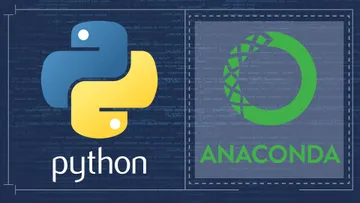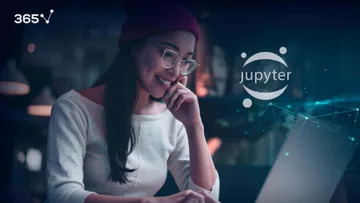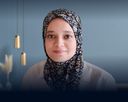Do you want to become a data scientist? If so, learning how to code in Python is one of the essential tools you will need to acquire. It is the most popular programming language data scientists use nowadays. In this article, we will provide several reasons why Python for data science makes sense, and how Python has established itself as the preferred tool of data scientists. In addition, we will talk about Jupyter - the environment that allows you to code in Python.
So, without further ado, let's answer the million (multimillion?) dollar question:
Why Python for Data Science?
Although it may be new to some of you, Python has been on the programming stage for over two decades. There are two main reasons you should have an introduction to Python programming. First, it has several technical advantages compared to other programming languages. And second, its practical application covers several industries. It is a powerful computational tool when we have to solve complicated tasks in the fields of finance, econometrics, economics, data science, and machine learning. Therefore, it is a perfect stepping stone for somebody who learns how to code and is determined to pursue a career as a data scientist.
Author's note: If you are interested in pursuing a career as a data scientist go ahead and download our free data science career guide that teaches you how to become a data scientist
What Is Python Good For
Here’s a slightly more technical description of Python.
It is an open-source, general-purpose high-level programming language.
Let’s break this definition into several pieces and try to understand each of these attributes.
Open-source software (OSS):
Open-source means it is free. Python has a large and active scientific community with access to the software’s source code and contributes to its continuous development and upgrading, depending on users’ needs. This is the main reason Python is cross-platform – it is available for all major operating systems: Windows, Mac, and Linux.
The benefit of it is Python can be quickly applied anywhere. Domain-specific languages, like MATLAB and SAS, also used for solving financial and econometric tasks, are paid. This plays a role in a language’s popularity.
General-purpose:
Yes, we will dig deeper in one of Python’s specific applications – data science. However, you should know there is a broad set of fields where it could be applied. For instance, Python can be used for web programming through the Django framework.
Although this is beyond the scope of this post, you should be aware the wide scope of application and the interoperability with other programming languages could be an explanation why some large organizations have chosen Python as their main programming language.
High-level language:
This is slightly more technical.
Broadly speaking, computers can run programs written in low-level languages only, also called machine languages. So, a program written in a high-level language must be first interpreted into a low-level language before it can be executed.
This process takes time. There is specialized software and applications that will do this interpretation for you. Nevertheless, the advantages of using a high-level language are huge!
It is difficult to code and understand low-level programming languages. They are too technical. High-level languages employ syntax a lot closer to human logic, which makes the language easier to learn and implement. It allows the programmer to focus on the task at hand, instead of trying to figure out unreadable lines of code.
Technical Advantages of Python
To summarize the technical advantages that make Python a powerful programming language, often preferred over other programming languages, we can say the following:
- Python is free and constantly updated;
- A programming langauge that can be used in multiple domains;
- Calculations processing does not require too much time and its syntax is intuitive allowing for complex quantitative computations.
These are the reasons that help us answer the question 'why Python for data science'.
Practical applicability
What we’ve said so far demonstrates Python’s enormous practical applicability. It is one of the most popular programming languages in several fields.
One of them is the world of finance.
Just consider, today, banks and financial institutions spend more on technology than any other industry! Thousands of developers work in financial institutions to maintain existing software and build new programs. There is a growing demand for people who have solid knowledge about the world of finance and Python programming.
It is clear we are living in the era of Big Data. People in different disciplines - economics, finance, computer science, marketing, and many more can retrieve huge amounts of data. We can talk about Big Data when we have millions of observations. In such situations, the computational capabilities of traditional data processing applications, like Microsoft Excel, become insufficient. We need a more powerful tool to tackle Big Data in more or less the same way, regardless of the field of application. Python is perfect for these situations, as it gives us flexibility.
To conclude, Python’s popularity lies on two main pillars. One is that it is an easy-to-learn programming language designed to be highly readable, with a syntax quite clear and intuitive.
And the second reason is its user-friendliness does not take away from its strength. Python can execute a variety of complex computations and is one of the most powerful programming languages preferred by specialists.
So, this pretty much answers the question 'why Python for data science'. However, there is much more to say about Python, like, how does it compare to other programming languages? And we've covered it all in our all-comprising Python Programming Guide.
Let's consider the environment where Python coding usually takes place.
Why Use Jupyter Notebook to Code in Python?
So, why isn’t there just one software application, called “Python”, you can install on your computer that is automatically being updated and that runs everything smoothly?
I am sorry to tell you, but it’s not the case. We have to deal with reality. First, Python is a programming language. It can allow you to communicate with the computer. To do that, you’ll need the help of a specific software or an application.
Namely, the Jupyter Notebook App, which is more often called Jupyter, can help us do that. It is a server-client application that allows you to edit your code through a web browser.
Consider the following visualization. All units represent different software.
On one side, you have several language kernels. These are programs designed to read and execute code in a specific programming language, like Python, R, or Julia. The Jupyter installation always comes with an installed Python kernel, and the other kernels can be installed additionally. On the other side, you have various types of interfaces, where you can write code. They represent the clients. An example of such a client is the web browser.
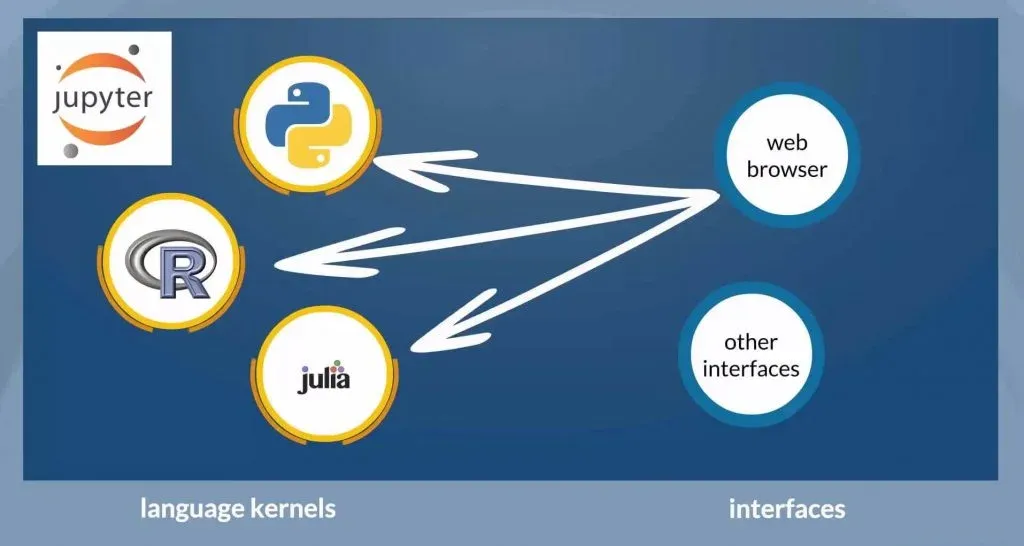
The Jupyter server provides the environment where a client is matched with a corresponding language kernel. In our case, we will focus on Python, and a web browser as a client, or as an interactive shell. Your work will be stored on a notebook document, and since we said we will be strictly using the Python language, it will be called “IPython Notebook” file, with the file format “dot ipynb”.
Having said all that, we can explain why Jupyter is used in so many large corporations, like Google, Microsoft, and IBM.
Jupyter is well-suited to demonstrations of programming concepts and training
First, in large corporations, solving a particular task could require coding in a few languages, say Python, R, Julia, or PHP. Instead of installing different interfaces for each language kernel you need, Jupyter allows you to use the same structure of the notebook type of file. Simply, each notebook you create will connect to the language kernel you request. Consider also, this file can be easily stored locally or on a remote server. Therefore, Jupyter facilitates the communication between teams in a corporation tremendously.
Second, Jupyter is not a text editor that opens a new window every time you execute a different part of your code, as is the case with some other software applications. In the same file, you can have pure text that can communicate a message to the reader, computer code like Python, and output containing rich text, like equations, figures, graphs, pictures, and others. This simplifies the process of the workflow immensely, and Jupyter Notebook is increasingly preferred over other software packages. That’s why we’ll use it too.
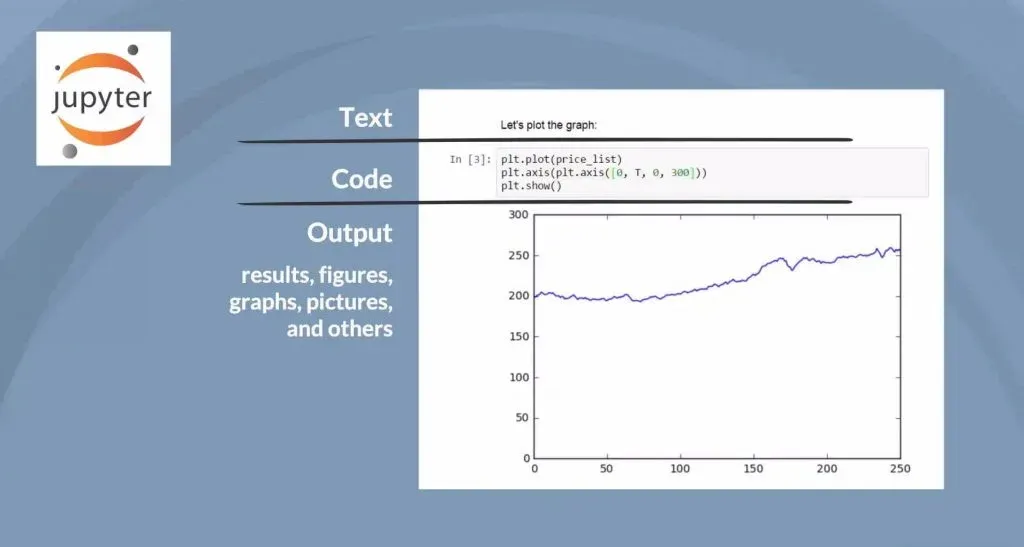
Now that you know the answer of the question 'why Python for data science', and which is the environment we use to code in Python, the obvious next step would be to install Anaconda - a software package that contains both the Python programming language and the Jupyter Notebook App. In our next tutorial, we will show you how to install Anaconda in a few easy steps. You can also take our Introduction to Jupyter course to start your programming journey.


